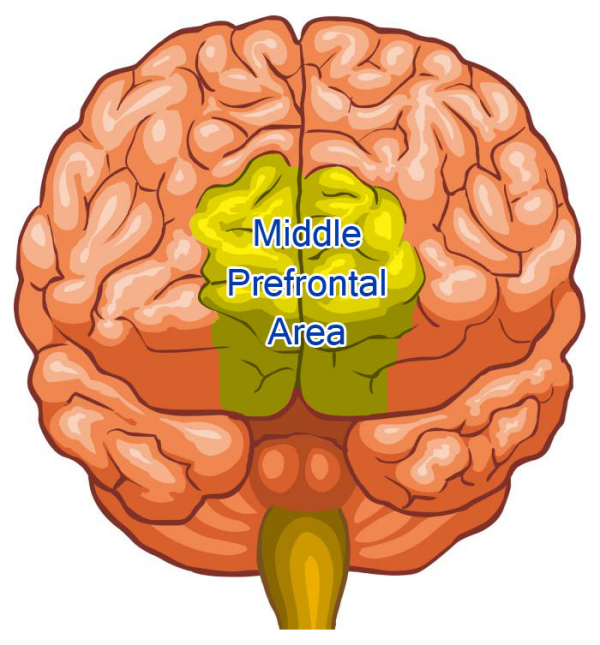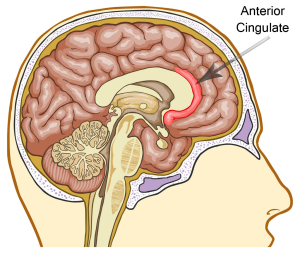Meditation and the Physical Transformation of the Brain: Part III
One of the really important structural changes we see due to long-term meditation occurs in the middle prefrontal areas of the brain. In recent blogs, I have discussed what scientists are learning about the structural changes in the thalamus, the left prefrontal cortex, and the parietal lobe. Here I will discuss the findings regarding the middle prefrontal areas.

To give you an example of where the middle prefrontal areas are, if you take your right hand, make a fist, and put your thumb inside your fingers (we’re going to use this as a model of the brain), we’d say that the bottom of the palm and the wrist represent the brain stem. The thumb represents the limbic brain. It represents everything that is in the center of the brain, including the thalamus. The folded fingers on the thumb represent the outer cortex and the outer layer of the brain. The two fingers in the middle, right from the fingernails up to the first knuckle, make up the middle prefrontal areas.
The middle prefrontal areas also include an area just behind the two middle fingers—just behind the fingernails. This very small part in the center of the brain is called the anterior cingulate. It’s just underneath the outer layer of the brain, right between the eyebrows. This is very interesting, because many forms of meditation, particularly in Hinduism, involve placing your attention in this area. Studies show that the anterior cingulate activity is changed through meditation, and specifically that these changes are correlated with greater levels of empathy, social engagement, and emotional balance.

Sara Lazar and colleagues conducted a study that found long-term mindfulness meditators exhibited a greater amount of gray matter in specific areas of the brain, as compared to beginner meditators and non-meditators. One of these areas was the middle prefrontal area. The fact that there was more gray matter seemed to indicate that, as their inner awareness developed, there was a corresponding shift in the physical nature of the brain.
There are several very important functions of the middle prefrontal areas that meditation seems to develop. The main functions have to do with body regulation, attuned communication, emotional balance, and responsive flexibility (which is the capacity to pause before action).Emotional balance has to do with our capacity to balance the limbic system, which allows us to possess an emotional sense of connection, warmth, and meaning, while at the same time not allowing that emotional energy to drive us into emotional chaos. These middle prefrontal areas are crucial in this process because they help us modulate emotion.
This area of the brain appears to play a vital role in modulating fear. Studies have shown that advanced meditators, and anyone actually learning meditation, can down regulate the part of the brain involved in fear, which is the amygdala. There is also often a release of gamma-aminobutyric acid (GABA) during meditation, which calms the limbic system.
By becoming more mindful in meditation, we’re actually able to regulate much of the anxiety, the worry, and the fear that seem to rule our lives on a very subtle level.In fact, we know that so many of the ailments and the illnesses that we suffer from today are stress-related. Stress is directly related to overstimulation of the amygdala—overstimulation of the fear response.
Another important aspect associated with the middle prefrontal areas is intuition. The middle prefrontal areas receive input from the viscera; that is, the heart, lungs, and intestines, for example. As the input comes in, and as we become more deeply aware of our body wisdom and the signals our body is giving us, these signals influence our reasoning and our reactions. The quality of our connection with the signals coming from our body deepens our intuition and deepens our wisdom, transforming our decision-making process into one based not purely on logic and reason, but on a deeper sense of incoming signals and input that is coming from our body.
Last, but not least, a very important aspect of the middle prefrontal areas is that they seem to mediate our ability to be aware of our awareness. With the growing awareness that comes with long-term meditation, what happens is we have a sense of presence. There’s a witnessing consciousness that allow us to be able to sort of “back up” from the trials and trammels of the mind and watch the mind—witness it. As we do that, brain scans have shown that these middle prefrontal areas actually become more and more active. I’d like to say that these middle prefrontal areas are the parts of the brain that help make us most human. They mediate the higher aspects of humanity.
As we practice meditation, what we’re generally doing is activating the CEO of the brain. We’re turning on and awakening, you could say, the parts of our brain that really hold, or at least help mediate or help facilitate and support, the unfolding of our highest potential.
___________________________________________________________________________
 Eric Thompson is a co-founder of iAwake Technologies, LLC and was its Chief Technology Officer. Although no longer with iAwake Technologies, his contributions have been immense. Eric is also an inventor, researcher, and producer, and is considered one of the world’s foremost brainwave entrainment experts. In addition, Eric is a pioneer in the development of biofield entrainment technology, which digitally captures and transmits life-enhancing and beneficial subtle energies to the human biofield via any digital medium, including pictures, audio, and film. By combining this emerging technology with an unconventional, innovative, and original approach to audio brainwave entrainment, Eric strives to make profound spiritual development and emotional freedom more easily accessible to all. He writes and speaks on the intersection between neuroscience, psychology, subtle energy, and spirituality.
Eric Thompson is a co-founder of iAwake Technologies, LLC and was its Chief Technology Officer. Although no longer with iAwake Technologies, his contributions have been immense. Eric is also an inventor, researcher, and producer, and is considered one of the world’s foremost brainwave entrainment experts. In addition, Eric is a pioneer in the development of biofield entrainment technology, which digitally captures and transmits life-enhancing and beneficial subtle energies to the human biofield via any digital medium, including pictures, audio, and film. By combining this emerging technology with an unconventional, innovative, and original approach to audio brainwave entrainment, Eric strives to make profound spiritual development and emotional freedom more easily accessible to all. He writes and speaks on the intersection between neuroscience, psychology, subtle energy, and spirituality.
___________________________________________________________________________
Leave a Comment
You must be logged in to post a comment.

Leave your comments below